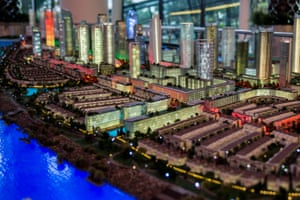On Track to Become an Undersea City
 |
| High rises, gated compounds and marinas: the Islands The Guardian |
"Nobody here believes in the greater good, because there is so much corruption, so much posturing about serving the public when what gets done only serves private interests."
"There is no trust."
Sidney Jones, director, Institute for Policy Analysis of Conflict, Indonesia
"We need big steps now. If all the discussions get tied up with fishermen and development, there will eventually be a massive calamity and deaths and no choice but to give up on whole parts of Jakarta."
"If this wall [newly built Coastal Wall] breaks, there's simply no holding back the Java Sea."
"Jakarta will flood all the way to the center of town, six kilometers from here. I could take you to twenty other places just like this."
Jan Jaap Brinkman, Dutch hydrologist
"Jakarta could become a 21st-Century version of Tokyo in the 20th Century, an example for urban redevelopment."
"A city that can't deliver basic services is a failed city. On top of conventional issues like flooding and urbanization, we now have climate change, tipping the scale."
"And at this rate, people will be fighting in the streets for increasingly limited resources like clean water and safe living spaces."
"Nature will no longer wait."
Irvan Pulungan, climate researcher, adviser to Jakarta's governor
 |
| Photo by CEphoto, Uwe Aranas. |
Jakarta may appear like a modern, technologically advanced city of the 21st Century with its freeways and skyscrapers, but look a little more critically and you see ports, high-rises, fish markets, slums, power plants, malls and polluted canals weaving their way through the area. Water is piped to fewer than half the population of 10-million, not by the authority of the municipality operating water plants, but by private companies charging extortionate rates through government concessions.
Rain forests in Indonesia have been burned down in favour of palm oil forests and the building of textile factories, causing air pollution floating over the country, reaching out to Malaysia. Waste and chemicals are dumped into waterways, leaving drinking water supply contaminated. The rural poor have migrated to the capital Jakarta to set up informal kampungs clustering along its canals, huts built on stilts, contaminating the waterways with their sewage.
 |
| Forget Venice. The fastest-sinking city is the Indonesian capital, parts of which are dropping at 25cm a year. Can an outlandish plan for a giant seawall and luxury waterworld city in the shape of a mythical bird save Jakarta from drowning? The Guardian |
Close to 40 percent of Jakarta now is below sea level.
The city suffers some of the worst traffic snarls in the world, while buildings sink in this city that suffers from lack of planning and municipal sewers. According to hydrologists, Jakarta has a decade in which to make an effort to halt its collapse into the sea. Over 97 percent of Jakarta is covered with concrete and asphalt; fields that once absorbed rain are no longer there. Shantytowns and apartment towers have displaced the native mangroves that once relieved monsoon-swollen rivers.
A former governor of Jakarta ordered the eviction of waterfront slums. He was a geological engineer by training, and as governor he undertook to solve some of the city's largest problems, to take control of the water supply from private companies, assembling a sanitation crew to remove sediment and garbage from rivers and canals, clearing out some of the informal slums obstructing waterways and soon a difference was seen as rain instead of causing floods, drained in hours.
He failed to be re-elected, opposition was so strong against his efforts. Replaced by Islamists in this most populous of all Muslim countries, he was brought up on charges of blasphemy and served a two-year prison sentence. Climate scientist Ardhasena Sopalheluwakan feels it would be best "to give back part of North Jakarta to nature", to "reintroduce mangroves and rejuvenate some of the dozens of reservoirs that were actually part of old Jakarta".
Just "counteracting subsidence will account for 90 percent of what this city needs to do to deal with climate change", according to to hydrologist, Jan Jaap Binkman. Post WWII, Tokyo had sunk four meters since 1900. The city poured resources into infrastructure and established stricter rules on development. In a decade Tokyo became a symbol of urban innovation, able to cope with the effects of climate change.
 |
| Photo by CEphoto, Uwe Aranas. |
Labels: Climate Change, Corruption, Indonesia, Jakarta, Pollution, Sinking
0 Comments:
Post a Comment
<< Home